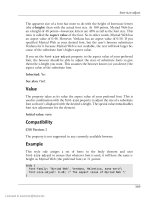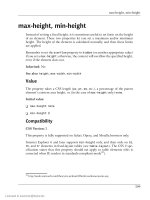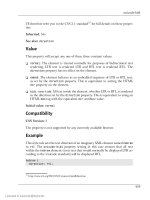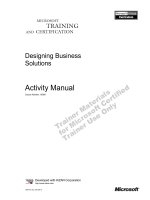Tài liệu Designing Without Tables Using CSS docx
Bạn đang xem bản rút gọn của tài liệu. Xem và tải ngay bản đầy đủ của tài liệu tại đây (982 KB, 171 trang )
HTML Utopia:
Designing Without Tables Using CSS
(Chapters 1, 3, 4, and 5)
Thank you for downloading these four chapters of Dan Shafer’s
HTML Utopia: Designing Without Tables Using CSS.
This excerpt encapsulates the Summary of Contents, Information
about the Author and SitePoint, Table of Contents, Preface, four
chapters of the book, and a portion of Appendix C: CSS Property
Reference.
We hope you find this information useful in evaluating the book.
For more information, visit sitepoint.com
Summary of Contents of this Excerpt
Preface xi
I. Introduction to CSS 1
1. Getting the Lay of the Land 3
3. Digging Below The Surface 49
II. Page Layout with CSS 73
4. CSS Web Site Design 75
5. Building the Skeleton 87
C. CSS Property Reference (A-D only) 309
Index 481
Summary of Additional Book Contents
I. Introduction to CSS 1
2. Putting CSS Into Perspective 23
II. Page Layout with CSS 73
6. Putting Things in Their Place 123
III. Styling Text and other Content with CSS 155
7. Splashing Around a Bit of Color 157
8. Making Fonts Consistent 173
9. Text Effects and the Cascade 193
10. Adding Graphics to the Design 241
IV. Non-Obvious Uses of CSS 255
11. Improving the User Experience 257
12. Validation and Backwards Compatibility 275
A. CSS Miscellany 293
B. CSS Color Reference 301
C. CSS Property Reference 309
Recommended Resources 473
HTML Utopia: Designing
Without Tables Using CSS
by Dan Shafer
HTML Utopia: Designing Without Tables Using CSS
by Dan Shafer
Copyright © 2003 SitePoint Pty. Ltd.
Editor: Georgina Laidlaw
Technical Editor: Kevin Yank
Illustrations and Cover Design: Julian Carroll
Printing History:
First Edition: May 2003
Notice of Rights
All rights reserved. No part of this book may be reproduced, stored in a retrieval system or transmitted
in any form or by any means, without the prior written permission of the publisher, except in the
case of brief quotations embodied in critical articles or reviews.
Notice of Liability
The author and publisher have made every effort to ensure the accuracy of the information herein.
However, the information contained in this book is sold without warranty, either express or implied.
Neither the authors and SitePoint Pty. Ltd., nor its dealers or distributors will be held liable for any
damages to be caused either directly or indirectly by the instructions contained in this book, or by
the software or hardware products described herein.
Trademark Notice
Rather than indicating every occurrence of a trademarked name as such, this book uses the names
only in an editorial fashion and to the benefit of the trademark owner with no intention of infringe-
ment of the trademark.
Published by SitePoint Pty. Ltd.
Suite 6, 50 Regent Street Richmond
VIC Australia 3121.
Web: www.sitepoint.com
E-Mail:
ISBN 0-9579218-2-9
Printed and bound in the United States of America
About the Author
Dan Shafer is a highly respected Web design consultant. He cut his teeth as the
first Webmaster and Director of Technology at Salon.com, then spent almost
five years as the Master Builder in CNET's Builder.com division.
Dan gained widespread recognition as a respected commentator on the Web
design scene when he hosted the annual Builder.com Live! conference in New
Orleans. He has designed and built more than 100 Websites and is regarded as
an expert in Web user experience design and implementation.
The author of more than 50 previous titles on computers and technology, Dan
lives in Monterey, California, with his wife of almost 25 years, Carolyn, and their
Shiitzu dog, Albert Einstein.
About SitePoint
SitePoint specializes in publishing fun, practical and easy-to-understand content
for Web Professionals. Visit to access our books,
newsletters, articles and community forums.
in the knowing that It is all there is.
ii
Table of Contents
Preface xi
Who Should Read This Book? xii
The Book's Web Site xiii
The Code Archive xiii
Updates and Errata xiii
The SitePoint Forums xiii
The SitePoint Newsletters xiii
Your Feedback xiv
Acknowledgements xiv
I. Introduction to CSS 1
1. Getting the Lay of the Land 3
CSS in Context 4
The Basic Purpose of CSS 5
Why Most—But Not All—Tables Are Bad 6
Tables Mean Long Load Times 6
Use of Transparent Images Slows Us Down 7
Maintaining Tables is a Nightmare 7
When it’s OK to Use a Table 8
What is CSS, Really? 8
Parts of a CSS Rule 10
Types of CSS Rules 12
What Properties Can CSS Rules Affect? 13
What Elements Can CSS Affect? 13
Where Can CSS Styles Be Defined? 14
Why Bother? 17
Summary 21
2. Putting CSS Into Perspective 23
What is CSS Good For? 23
Color and CSS 24
Fonts and CSS 28
Pseudo-Class Animation and CSS 30
Images and CSS 31
Multiple Style Sheets, Users, and CSS 33
What CSS Alone Can’t Do For You 34
CSS and Web Accessibility 36
CSS and the Ever-Shifting World of Browsers 42
Accommodating Older Browsers 44
Dealing with Broken Browsers 46
Summary 47
3. Digging Below The Surface 49
Applying CSS to HTML Documents 50
Using Shorthand Properties 51
How Inheritance Works in CSS 51
Selectors and Structure of CSS Rules 54
Universal Selector 56
Element Type Selector 56
Class Selector 57
ID Selector 58
Pseudo-Element Selector 59
Pseudo-Class Selector 60
Descendant Selector 61
Parent-Child Selector 62
Adjacent Selector 62
Attribute Selectors 63
Selector Grouping 65
Expressing Measurements 65
Absolute Values 66
Relative Values 68
CSS Comments 70
Summary 71
II. Page Layout with CSS 73
4. CSS Web Site Design 75
Advantages of CSS Design 76
Increased Stylistic Control 76
Centralized Design Information 77
Semantic Content Markup 78
Accessibility 79
Standards Compliance 80
CSS Success Stories 82
Our Sample Site: Footbag Freaks 83
Summary 85
5. Building the Skeleton 87
Enumerating Design Types 88
How Many Page Types? 88
How Many Design Elements? 89
CSS Positioning and Multi-Column Page Layouts 90
HTML Utopia: Designing Without Tables Using CSS
Order this 500 page hard-copy CSS Book Now!iv
The CSS Box Model 90
The display Property 112
CSS Positioning and Multi-Column Layouts 113
Absolute, Relative, and Positioning Contexts 113
Basic Three-Column Layout 117
Adding a Top Header Area 120
Summary 121
6. Putting Things in Their Place 123
More on Positioning Page Blocks 123
Measurement Units and Types Influence Design 123
The float Property 125
The clear Property 127
Absolute Versus Relative Heights and Widths 131
The z-Index Property and Overlapping Content 140
CSS Layout in Practice: Footbag Freaks 145
Summary 153
III. Styling Text and other Content with CSS 155
7. Splashing Around a Bit of Color 157
Who’s in Charge Here? 157
Color in CSS 159
How to Specify Colors 159
Color Selection and Combining Colors 162
Setting body Color 164
Transparency, Color, and User Overrides 165
Interesting Uses of Color 166
Warnings and Cautions 166
Coloring Alternate Rows of Data Tables 169
Summary 172
8. Making Fonts Consistent 173
How CSS Deals With Fonts 173
The font-family Property 174
The font-size Property 176
HTML Sizes Versus CSS Sizes 176
Variability Across Browsers and Platforms 177
Relative to What? 178
Other Font Properties 180
The font-style Property 180
The font-variant Property 180
The font-weight Property 181
vOrder this 500 page hard-copy CSS Book Now!
HTML Utopia: Designing Without Tables Using CSS
The font Shorthand Property 181
Standard and Nonstandard Font Families 184
Specifying Font Lists 186
Using Nonstandard and Downloadable Fonts 188
Summary 191
9. Text Effects and the Cascade 193
Using the span Element 194
Text Alignment as a Design Technique 196
Text Alignment in CSS Versus HTML 197
Moving from Crowded to Airy Design with Alignment 197
First-Line Indentation 203
Horizontal and Vertical Spacing 206
The line-height Property 206
The letter-spacing and word-spacing Properties 209
Text Decorations 214
Shadowed Text Without Graphics 219
Styling Hyperlinks 221
Styling Lists with CSS 224
The list-style-type Property 224
The list-style-position Property 229
The list-style-image Property 231
Cascading and Inheritance 233
Basic Principles of Cascading 233
Sort Order 235
Specificity 237
Origin 239
Weight (!important) 239
Summary 240
10. Adding Graphics to the Design 241
Alignment of Images and Text 242
Placing Text On Top of Images 245
Clipping HTML Content 250
Summary 253
IV. Non-Obvious Uses of CSS 255
11. Improving the User Experience 257
Basic List Styling With CSS 259
Enhancing the Look of the Menu 265
Creating a Submenu within the Main Menu 266
Modifying the Cursor on the Fly 269
HTML Utopia: Designing Without Tables Using CSS
Order this 500 page hard-copy CSS Book Now!vi
Using a Background Image as a Fixed Canvas 271
Summary 274
12. Validation and Backward Compatibility 275
Validating Your CSS 275
Adjusting for Backward Compatibility 279
Which Are the Non-Conforming Browsers? 280
Basic Approaches to Non-Conforming Browsers 281
Accommodating Netscape 4.x 285
Keep the Quirks: DOCTYPE Switching 288
Summary 291
A. CSS Miscellany 293
At-Rules 293
Aural Style Sheets 297
CSS and JavaScript 299
B. CSS Color Reference 301
C. CSS Property Reference 309
azimuth 309
background 310
background-attachment 311
background-color 312
background-image 313
background-position 314
background-position-x, background-position-y 316
background-repeat 317
behavior 318
border 319
border-bottom, border-left, border-right, border-top 320
border-bottom-color, border-left-color, border-right-color, border-top-
color 321
border-bottom-style, border-left-style, border-right-style, border-top-
style 322
border-bottom-width, border-left-width, border-right-width, border-
top-width 322
border-collapse 323
border-color 324
border-spacing 326
border-style 326
border-width 328
bottom 329
viiOrder this 500 page hard-copy CSS Book Now!
HTML Utopia: Designing Without Tables Using CSS
caption-side 331
clear 332
clip 332
color 334
content 335
counter-increment 338
counter-reset 339
cue 340
cue-after, cue-before 341
cursor 342
direction 344
display 346
elevation 351
empty-cells 351
filter 352
float 354
font 355
font-family 357
font-size 359
font-size-adjust 361
font-stretch 363
font-style 364
font-variant 365
font-weight 366
height 368
ime-mode 369
layout-flow 370
layout-grid 371
layout-grid-char 372
layout-grid-line 373
layout-grid-mode 374
layout-grid-type 375
layer-background-color 376
layer-background-image 377
left 379
letter-spacing 380
line-break 381
line-height 382
list-style 383
list-style-image 385
list-style-position 386
list-style-type 388
HTML Utopia: Designing Without Tables Using CSS
Order this 500 page hard-copy CSS Book Now!viii
margin 390
margin-bottom, margin-left, margin-right, margin-top 391
marker-offset 392
marks 394
max-height, min-height 394
max-width, min-width 396
-moz-border-radius 397
-moz-border-radius-bottomleft, -moz-border-radius-bottomright, -moz-
border-radius-topleft, -moz-border-radius-topright 398
-moz-opacity 400
orphans 401
outline 402
outline-color 403
outline-style 404
outline-width 405
overflow 406
overflow-x, overflow-y 408
padding 409
padding-bottom, padding-left, padding-right, padding-top 410
page 412
page-break-after 413
page-break-before 414
page-break-inside 416
pause 417
pause-after, pause-before 418
pitch 418
pitch-range 420
play-during 420
position 422
quotes 423
richness 425
right 426
ruby-align 427
ruby-overhang 428
ruby-position 430
scrollbar-base-color 431
scrollbar-element-color 432
size 434
speak 435
speak-header 435
speak-numeral 436
speak-punctuation 437
ixOrder this 500 page hard-copy CSS Book Now!
HTML Utopia: Designing Without Tables Using CSS
speech-rate 438
stress 439
table-layout 440
text-align 441
text-align-last 442
text-autospace 443
text-decoration 444
text-indent 445
text-justify 446
text-kashida-space 448
text-overflow 449
text-shadow 450
text-transform 451
text-underline-position 452
top 453
unicode-bidi 454
vertical-align 457
visibility 459
voice-family 460
volume 461
white-space 462
widows 464
width 465
word-break 466
word-spacing 467
word-wrap 468
writing-mode 469
z-index 470
zoom 471
Recommended Resources 473
Index 481
HTML Utopia: Designing Without Tables Using CSS
Order this 500 page hard-copy CSS Book Now!x
Preface
I was already in my 50s when the World Wide Web burst upon the scene. Having
spent most of my life to that point as a writer and editor, I naturally gravitated
to the publishing side of the coin, rather than remaining content to be an amazed
consumer of all the wonderful information and connections that began to flow
from it.
As I saw the first version of the first graphical Web browser before it was officially
released, some might say I’ve been there from the beginning. And one thing that
bothered me from that beginning, as an author and publisher, was the inability
to disentangle content from presentation. The interconnectedness of it all meant
that, to produce a Website, you needed not only something to say, and some
graphical designs to make the site look good, but you also needed to be a bit of
a programmer. Initially, this “programming” was a pretty lightweight task to
someone like me who had a broad but thin programming background. HTML
markup, when all was said and done, wasn't really programming. Still, it was
more than just writing words. And it was more than using a word processor to
format words.
Designers who had clear ideas of how they wanted their Web pages to look were
frustrated and stymied by the need to create complex sets of deeply nested tables
even to approximate their visions. And, as designers came up with increasingly
complex ideas, and Web browsers diverged further and further from standards
and compatibility, the Web threatened to collapse under its own weight. Serious
designers began lobbying for a complete break from HTML to some new approach
to the Web. Chaos reigned.
I was at CNET’s Builder.com at the time, chronicling all of this, as well as parti-
cipating in it both as a designer and as a pundit. I was one of the founding
members of the Web Standards Project, or WaSP[1], and I helped found the
major conference where Web designers and creators gathered at Builder.com Live!
in New Orleans. So I had a front-row seat as we gradually figured out the best
way to deal with this problem.
The Holy Grail of the Web, then, was the notion that authors should write, de-
signers should design (and code HTML) and programmers should… well… pro-
gram. Those boundaries were not clean in the first few years of the Web.
[1] />Then, along came Cascading Style Sheets (CSS), the subject of this book. The
governing forces of the Web, through the World Wide Web Consortium, better
known as the W3C[2], addressed the problem and proposed that we divide
presentation instructions, and structural markup with content, into two separate
kinds of files.
Things haven’t been the same since, thank goodness! Now we really can (mostly)
separate what we say from how it gets presented to the user in a Web browser.
I wager that most Web developers today are fairly comfortable with CSS and
would no more think of embedding presentation instructions in their HTML
than they’d consider mixing 23 fonts on the same Web or print page.
Since CSS emerged, there have been dozens of books written about it. So when
SitePoint approached me about doing a CSS book, my first thought was, “Who
needs another CSS book?” But as they began to reveal their vision to me, it made
sense. It was indeed time for a book that took a different tack, based on the ex-
tensive experience of the Web design community.
So, this book is different in two primary ways.
First, it focuses on the question of how to accomplish with CSS some of the
successes Web designers have spent significant time and energy to create using
nested tables. Said another way, this book doesn’t try to start from scratch and
become a CSS tutorial. Instead, it’s a sort of introductory CSS design guide.
Second, it starts at the outside and works its way in. Most, if not all, other CSS
books, focus first on the little pieces: the attributes, values, and tags that comprise
the syntax of CSS. They then explain how to put those pieces together into a
Website.
This book begins by looking at how CSS should influence the entire design of a
site, and how to put the CSS framework in place before you begin to deal with
individual HTML elements and their styling.
Who Should Read This Book?
As I wrote this book, I had in mind Web designers with at least a little experience
building sites, who are curious about how CSS can help them become more ef-
fective designers. It is, then, aimed at a beginner to intermediate designer. I shall
assume a strong grasp of HTML, but that's about it.
[2] />Preface
Order this 500 page hard-copy CSS Book Now!xii
The Book's Web Site
Located at the Website supporting this book
will give you access to the following facilities:
The Code Archive
As you progress through the text, you'll note a number of references to the code
archive. This is a downloadable ZIP archive that contains complete code for all
the examples presented in the book. You'll also find a copy of the Footbag Freaks
Website[4], which we use as an example throughout the book.
Updates and Errata
No book is perfect, and I expect that watchful readers will be able to spot at least
one or two mistakes before the end of this one. The Errata page on the book's
Website will always have the latest information about known typographical and
code errors, and necessary updates for new browser releases and versions of the
CSS standard.
The SitePoint Forums
If you’d like to communicate with me or anyone else on the SitePoint publishing
team about this book, you should join SitePoint’s online community[5]. In fact,
you should join that community even if you don’t want to talk to us, because
there are a lot of fun and experienced Web designers and developers hanging out
there. It’s a good way to learn new stuff, get questions answered (unless you really
enjoy being on the phone with some company’s tech support line for a couple of
hours at a time), and just have fun.
The SitePoint Newsletters
In addition to books like this one, SitePoint publishes free email newsletters in-
cluding The SitePoint Tribune and The SitePoint Tech Times. In them, you'll read
about the latest news, product releases, trends, tips, and techniques for all aspects
of Web development. If nothing else, you'll get the useful CSS articles and tips,
[4] />[5] />xiiiOrder this 500 page hard-copy CSS Book Now!
The Book's Web Site
but if you're interested in learning other technologies, you'll find them especially
useful. Sign up to one or more SitePoint newsletters at e-
point.com/newsletter/.
Your Feedback
If you can't find your answer through the forums, or if you wish to contact us for
any other reason, the best place to write is <>. We have a
well-manned email support system set up to track your inquiries, and if our
support staff is unable to answer your question, they send it straight to me.
Suggestions for improvements as well as notices of any mistakes you may find
are especially welcome.
Acknowledgements
A huge vote of thanks and appreciation goes to Kevin Yank, Technical Editor of
this book. SitePoint as a publisher has a radically different approach than any
other publisher I’ve dealt with. Kevin taught me a lot about CSS, argued with
me about details when necessary, and generally made a major and measurable
contribution to the technical quality of this book. In particular, he wrote the
impressive Appendix C. Needless to say, errors remain my responsibility, but I
can tell you that any errors that slipped through are my fault, and not due to a
lack of understanding on Kevin’s part. He must eat, sleep, and breathe W3C
specs.
Also immensely influential on this book was Editor Georgina Laidlaw. She kept
the project as on schedule as it could be, acted as a liaison between Kevin and I,
and copy-edited the text to make sure my propensity to write incredibly long
sentences was curbed. Plus, she was a joy to work with.
Julian Carroll, Designer, created the graphic design for the book, did almost all
the graphics work, and designed the Footbag Freaks sample Website[7] to boot.
He also wrote the article that was the original inspiration for this book: HTML
Utopia: Designing without Tables using CSS[8].
Mark Harbottle, SitePoint’s CEO, approached me with the concept, negotiated
the deal, and remained flexible during sometimes difficult periods as the book
[7] />[8] />Preface
Order this 500 page hard-copy CSS Book Now!xiv
evolved and grew and shrank and missed deadlines. He was never anything less
than a professional and a gentleman.
Jeff Soulé, a bright technology guy who also happens to be married to my lovely
oldest daughter Sheila, read some of the chapters of the book as it was being
written, learned some CSS in the process, and offered several helpful suggestions
that led to clearer explanations of some points.
Two world-class Web designers, Eric Meyer and Jeffrey Zeldman, helped me
through, with their writing, their examples, and their dogged determination that
CSS be understandable to, and usable by, all Web designers.
Finally, my wife, Carolyn, continues to stand by her man despite long hours, blue
air, bouts of self-doubt and depression, periods of inexplicable and incomprehens-
ible joy, and reams of techno-speak. She is, as always, my primary inspiration
and life teacher, without whom none of this would be possible or make sense.
xvOrder this 500 page hard-copy CSS Book Now!
Acknowledgements
xvi
Introduction to CSS
I









